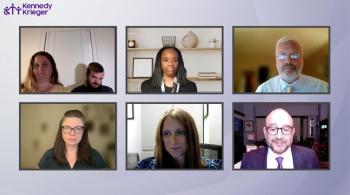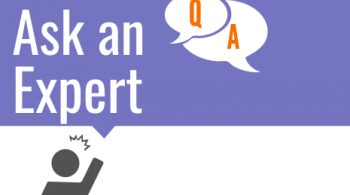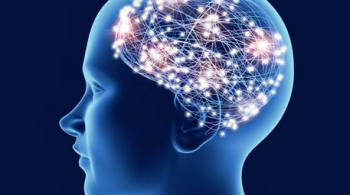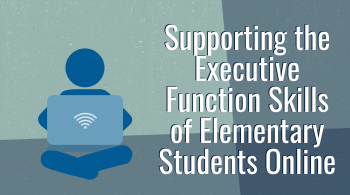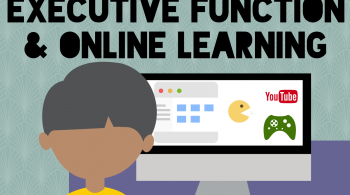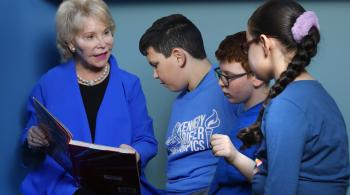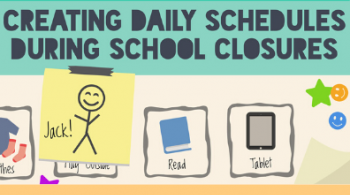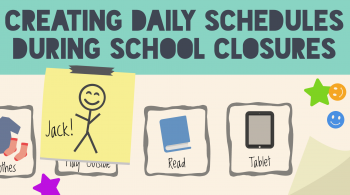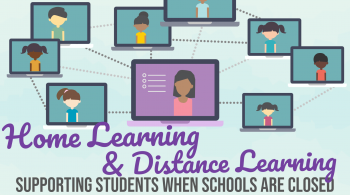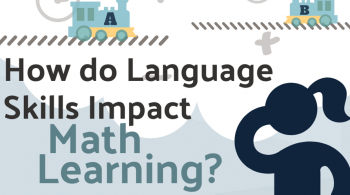11/15/16
By: Matthew Fasano, M.A., Danielle Previ, B.S., Kaycee Reese, M.Ed., Yessica S. Rodriguez, M.A., Rachael Plotkin, Ph.D., Jennifer Reesman, Ph.D., & Jill Pineda, Ph.D.
In our work in the Deafness-Related Evaluations and More (DREAM) Clinic at Kennedy Krieger Institute, we have encountered a number of myths and common misconceptions about individuals who are Deaf or Hard of Hearing. Students who are Deaf or Hard of Hearing require a unique set of considerations to ensure they are provided access to language and communication at home and in school. The first step in ensuring educators are prepared to support children who are Deaf or Hard-of-Hearing is to clarify some common misconceptions.
MYTH: It is best to pick only one language for Deaf or Hard of Hearing children, such as English or American Sign Language.
FACT: This is one of the most common myths that have persisted despite multiple scientific studies over years proving it to be false. Since we are focused on the brain, neuroscience, and telling you the honest-to-goodness scientific good stuff, let us boil it down. Human brains are built for language. Language acquisition research consistently demonstrates that humans start learning language from birth (Kuhl, 2010). The languages a child is exposed to will be the ones that child will use. Use of multiple languages and exposure to multiple languages from an early age is not a challenge for your amazing brain (Carlson & Meltzoff, 2008). In contrast, it is more challenging to learn a second or third language later in life. Ask anyone who started learning a second language in college, or who grew up with extended family members that used another language – learning any language takes place most naturally during infancy and childhood.
Now, what is language? This is not a trick question - a language has to have certain characteristics, like grammar and syntax. English, Spanish, and American Sign Language (ASL) are each distinct languages, and each are treated by your brain the same way (Leonard et al., 2013).
So, from your brain’s perspective – language is language. Period. Whether it is ASL or English, your brain likes language and learns it most easily at the earliest age possible. All of our language learning starts at birth and occurs most naturally during infancy and early childhood. Providing Deaf or Hard of Hearing children with accessible language is crucial, which is one of the reasons why newborn hearing screenings are conducted at birth. This allows parents to identify if any supports are needed to provide that critical access to language as soon as possible.
Since the human brain is capable of learning multiple languages and learns them naturally during infancy and early childhood – there is no scientific basis for limiting a Deaf or Hard of Hearing child’s access to multiple languages. This is particularly important for children who are Deaf or Hard of Hearing, as it is critical to ensure their full access to language (Humphries et al, 2012). If a child does not have auditory access to speech sounds, providing access to visual language (i.e., American Sign Language) will support their early language and literacy development (Allen, Letteri, Choi, & Dang, 2014).
MYTH: Students who are Deaf or Hard of Hearing and wear hearing aids in the classroom can hear everything just fine.
FACT: While hearing aids certainly benefit many students who are Deaf or Hard of Hearing, the level of benefit they provide is different for everyone. Hearing aids don’t “cure” hearing loss, but rather, they provide benefit and improvement in hearing (American Speech-Language-Hearing Association, 2016). The level of benefit children get from hearing aids should be regularly re-evaluated and monitored by an audiologist. Children’s ear canals are rapidly growing and changing, which can affect the amount of sound pressure and gain needed to make speech audible. It is also important to note that hearing aids amplify sound, not increase clarity of sound. It may be difficult for children to communicate when certain sounds or frequencies are being over-amplified or under-amplified, and they may not actually be getting as much amplification as they need. It is also critical for educators to know how to help students care for their hearing aids (McKay, Gravel & Tharp, 2008). Batteries can die and need regular changing to ensure the hearing aid is functioning properly. In young children, this requires adult assistance and frequent check-ins from parents and teachers.
To better understand what it may be like with different access to sound and in different settings, check out this hearing loss simulator.
MYTH: All individuals who are Deaf or Hard of Hearing can read lips – I just have to look at them directly to make sure they can understand.
FACT: What many refer to as lip reading is the skill of speech reading. If you have typical hearing, you probably engage in speech reading without even knowing it – try closing your eyes while watching TV, and you are more likely to miss some of what is said. We all naturally use the information available to us to make sense of the language around us. Even babies start looking at the mouth movements of a speaker early in their development. If only speech reading is used, estimates vary, but even those individuals who are most skilled with speech reading can only access about 30 – 40% of what is being said (Barnett, 2002). That means that if Deaf individuals are only given access to speech reading, they are likely missing a substantial amount of information.
Rather, it is important to consider how you can make information accessible. Use an individual’s preferred method of communication rather than making assumptions about how the person communicates. Individuals who are Deaf or Hard of Hearing have a wide variety of preferred methods of communication (e.g., American Sign Language, Cued Speech, spoken language, total communication [sign & spoken language], augmentative communication, and written communication), which can vary depending on their environment or communication partners.
Part of this myth holds a little truth! Looking directly at whomever you are communicating with always makes communication easier – especially if you may be working with a sign language interpreter. Having good lighting and minimizing distractions (e.g., busy patterns on your clothing, excessive jewelry) can also facilitate better communication.
MYTH: Deaf people read braille.
FACT: Braille, a system in which characters are represented by a pattern of raised dots that can be read by the fingers, is typically used by people who are blind, have low vision, or are Deaf-blind. Perkins eLearning has more information on learning braille and offers various braille literacy resources.
MYTH: Deaf people can’t drive.
FACT: The US Department of Transportation has recognized that individuals who are Deaf or Hard of Hearing are as safe as drivers who are hearing. In 2013, the United States Department of Transportation announced that Deaf drivers can operate commercial motor vehicles such as large trucks, after decades of a standard that did not allow Deaf individuals to obtain commercial drivers’ licenses. Based on research cited by the Department of Transportation, individuals who are Deaf are just as safe as hearing drivers. The National Association of the Deaf has more information.
MYTH: Teaching a child American Sign Language (ASL) will interfere with the development of English reading skills.
FACT: ASL can serve as a valuable tool when teaching children to be proficient English readers and writers (Wilbur, 2000). ASL is a full and rich language with its own vocabulary and grammar. Therefore, children who are fluent in ASL have knowledge of nouns, verbs, sentence structure, and so on. Just as hearing children learn phonology and letter sounds in English, emergent readers who are deaf can build the same level of language organization –which we call “phonology” — from the rhythmic-temporal patterned visual sequences that they see around them (including patterns of fingerspelling and mouth units). This is called Visual Sign Phonology. It has powerful implications for reading success and teaching young Deaf children to read. Children, parents, and teachers can capitalize on the use of ASL to support the development of corresponding English knowledge and skills (Allen, Letteri, Choi, & Dang, 2014). In this way, ASL fluency can support strong English literacy skills. Visit the Visual Language and Visual Learning Center for more research on the use of American Sign Language.
Correcting misconceptions is the first step to deep learning. We hope that this piece has assisted in a deeper understanding of the needs of Deaf and Hard of Hearing students. All students deserve access to meaningful education and communication.
References:
Allen, T.E., Letteri, A., Choi, S.H., & Dang, D. (2014). Early visual language exposure and emergent literacy in preschool deaf children: findings from a national longitudinal study. American Annals of the Deaf 159(4), 346-358.
American Speech-Language-Hearing Association (ASHA) (2016, November). Myths and Facts about Hearing Aids. Retrieved from http://www.asha.org/public/hearing/Hearing-Aid-Myths-and-Facts/
Barnett, Steven. (2002). Communication with Deaf and Hard-of-Hearing People: A Guide for Medical Education. Academic Medicine, 77(7), 694 – 700.
Carlson, S. & Meltzoff, A. (2008). Bilingual Experience and Executive Functioning in Young Children. Developmental Science, 11(2), 282-298.
Humphries, T., Kushalnagar, P., Mathur, G., Napoli, DJ, Padden, C., Rathmann, C., & Smith, SR (2012). Language acquisition for deaf children: reducing the harms of zero tolerance to the use of alternative approaches. Harm Reduction Journal. 9 (16). doi: 10.1186/1477-7517-9-16
Kuhl, P. K. (2010). Brain Mechanisms in Early Language Acquisition. Neuron, 67(5), 713–727. http://doi.org/10.1016/j.neuron.2010.08.038
Leonard, M.K., Ramirez, N.F., Torres, C., Hatrak, M., Mayberry, R.I., & Halgren, E. (2013). Neural stages of spoken, written, and signed word processing in beginning second language learners. Frontiers in Human Neuroscience, 7 (322).
McKay, S., Gravel, J.S., & Tharp, A.M. (2008). Amplification considerations for children with minimal or mild bilateral hearing loss and unilateral hearing loss. Trends in Amplification, 12 (1), 43-54.
Wilbur, R. (2000). The use of ASL to support the development of English and literacy. Journal of Deaf Studies and Deaf Education, 5(1), 81-104.
Visual Language and Visual Learning Science of Learning Center. (2011, January). Advantages of Early Visual Language (Research Brief No. 2). Washington, DC: Sharon Baker.

